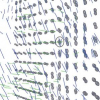Free Online Productivity Tools
i2Speak
i2Symbol
i2OCR
iTex2Img
iWeb2Print
iWeb2Shot
i2Type
iPdf2Split
iPdf2Merge
i2Bopomofo
i2Arabic
i2Style
i2Image
i2PDF
iLatex2Rtf
Sci2ools
ICCV
2007
IEEE
2007
IEEE
On the Differential Geometry of 3D Flow Patterns: Generalized Helicoids and Diffusion MRI Analysis
Configurations of dense locally parallel 3D curves occur in medical imaging, computer vision and graphics. Examples include white matter fibre tracts, textures, fur and hair. We develop a differential geometric characterization of such structures by considering the local behaviour of the associated 3D frame field, leading to the associated tangential, normal and bi-normal curvature functions. Using results from the theory of generalized minimal surfaces we adopt a generalized helicoid model as an osculating object and develop the connection between its parameters and these curvature functions. These developments allow for the construction of parametrized 3D vector fields (sampled osculating objects) to locally approximate these patterns. We apply these results to the analysis of diffusion MRI data via a type of 3D streamline flow. Experimental results on data from a human brain demonstrate the advantages of incorporating the full differential geometry.
Associated 3D Frame | Bi-normal Curvature Functions | Computer Vision | Curvature Functions | ICCV 2007 | Parallel 3D Curves | Parametrized 3D Vector |
| Added | 14 Oct 2009 |
| Updated | 30 Oct 2009 |
| Type | Conference |
| Year | 2007 |
| Where | ICCV |
| Authors | Peter Savadjiev, Steven W. Zucker, Kaleem Siddiqi |
Comments (0)

